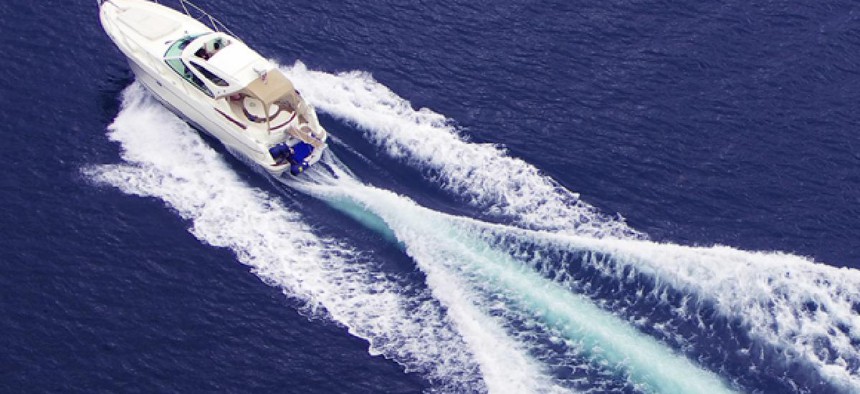DHS drones scout Caribbean for cartel speedboats, submarines

Beneda Miroslav/Shutterstock.com
Homeland Security is deploying remotely piloted aircraft to pinpoint stealthy vessels off the coast of Mexico.
The Homeland Security Department is flying unmanned aircraft over the Caribbean to hunt for narcotics-laden submarines and speedboats, DHS officials told Nextgov.
As DHS’ Customs and Border Protection has strengthened security along the U.S.-Mexico land border, drug traffickers have turned to far-off waterways and more discreet modes of transportation to smuggle tons of cocaine and marijuana, according to Homeland Security officials. CBP’s remotely piloted Guardian aircraft, which flies out of Florida and Texas, is among the tools U.S. authorities are using to fight back in this cat-and-mouse game.
“U.S. Customs and Border Protection constantly monitors activity and trends of transnational criminal organizations and works closely with other federal, state, local, tribal and international partners to combat smuggling in the source and transit zones,” a CBP spokeswoman told Nextgov. “CBP's Guardian is supporting drug-interdiction operations in the Caribbean.”
In May, the Homeland Security inspector general recommended CBP stop buying drones until the agency maximizes the flight hours of its existing fleet of 10 unmanned aircraft and develops a realistic budget for maintaining them. The drones sit idle 63 percent of the time that the vehicles are supposed to be in the air, according to an IG audit.
The Guardian, a maritime version of Homeland Security’s other Predator drones, is outfitted with search radar and an electro-optical/infrared sensor.
Submarines and semisubmersible vessels are harder for authorities to detect than the discreet, fast-moving cargo boats called pangas, according to the Joint Interagency Task Force South, a command comprising staff from DHS and the intelligence community as well as the Defense and Justice departments. With about $1 million, a crime ring can build a semisubmersible boat that yields more than $100 million in cocaine profits, Rear Adm. Charles Michel, director of Joint Interagency Task Force South, said at a House hearing Tuesday.
Before 2011, the semisubmersibles had traveled only through the Eastern Pacific, but since July 2011, the command has helped disrupt five such vessels in the Western Caribbean, each carrying more than 6.5 metric tons of cocaine. The command has documented about 215 incidents involving the semisubmersibles, but only 45 were disrupted mainly because they are so furtive.
“The semisubmersible and fully submersible vessels are stealthy vessels,” Michel said. “They are not all that fast but they try to avoid detection. The pangas are primarily out there because they are small and very speedy.”
Fully submerged submarines can transport up to 10 metric tons of cocaine at speeds of up to 6,800 nautical miles, he said. While no shipments to the United States have been identified, the vessels are capable of traveling from the west coast of Colombia to coastal Los Angeles, or from the north coast of Colombia to Galveston, Texas. The boats are powered by complex diesel-electric systems that allow them to sail submerged by day on battery power and on the surface at night while recharging their batteries. In 2011, the command documented three submarines, none of which was successfully intercepted.
Michel said both types of submerged boats are “potentially an even more insidious threat to the security of the United States” than the pangas because of their capacity and the extraordinary difficulty in spotting them. “These dangerous drug conveyances could be adapted for transporting other more serious security threats to the United States,” he said.
Lawmakers on the House Homeland Security Committee's border security panel repeatedly have told Homeland Security to reuse military assets, such as Defense drones and blimp-like aerostats, which have wide-angle cameras, now that many are no longer being deployed in combat.
DHS officials have consistently replied that they need more money to hire veterans to operate the machinery and to maintain vehicle parts.
“I know that there has been some of the aerostat technology that’s been available,” Donna Bucella, assistant commissioner for the CBP Office of Intelligence and Investigative Liaison, told the panel at Tuesday’s hearing. “The problem, or challenge, for us is the funding part.”
Committee member Rep. Mike Rogers, R-Ala., said, “That’s our problem. You just need to tell us what you need. It’s our problem to figure out if we can pay for it or not.”
Bucella praised the returning troops she has been able to employ.
“One of the greatest assets that we’re getting are the people,” she said. “As we’re doing the drawdown, I’ve hired seven full-motion video analysts. It’s a unique a skill set. And obviously for those who’ve been in the combat zone that’s been terrific.” The agency also has purchased helicopters retired from the Marine Corps, Bucella said.
She asked that lawmakers, such as Rogers, who want DHS to use more Defense equipment to consider funding vehicle operations and upkeep. “While they have some great air assets, they cost a lot of money to maintain,” Bucella said.
(Image via Beneda Miroslav /Shutterstock.com)
NEXT STORY: Government Data Creates All Kinds of Awesomeness



